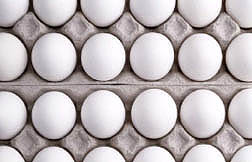This page has been archived and is being provided for reference purposes only. The page is no longer being updated, and therefore, links on the page may be invalid.
Read the magazine story to find out more. |
|
|
New Food Safety Technology Developed for Eggs
By Laura McGinnisMay 8, 2009
Good news for fans of raw cookie dough: Agricultural Research Service (ARS) scientists have filed a patent on technology that can protect pasteurized liquid eggs from food safety threats.
These threats include both naturally-occurring spoilage bacteria and pathogens. But don't go running for that dough just yet; the U.S. Food and Drug Administration still cautions against consuming raw, unpasteurized eggs or products that contain them.
The new technology was developed by Sudarsan Mukhopadhyay, Peggy Tomasula and John Luchansky, researchers at the ARS Eastern Regional Research Center (ERRC) in Wyndmoor, Pa.
Current pasteurization technology removes heat-sensitive pathogens, but some heat-resistant spoilage microorganisms can survive. Consumers can avoid illness by properly preparing and cooking eggs before consumption, but the researchers have found that new technology can compensate for the shortcomings of thermal pasteurization.
The technology, called "crossflow microfiltration membrane separation" (CMF), removes more pathogens than thermal pasteurization. And it does so without affecting the eggs' ability to foam, coagulate and emulsify, meaning that CMF-treated eggs could be safely substituted for pasteurized eggs in angel food cake and other products where those characteristics are desired.
In a pilot-scale study, CMF was shown to remove about 99.9999 percent of inoculated Salmonella enteritidis from unpasteurized liquid egg whites. The technology can also be used to remove Bacillus anthracis spores from egg whites. This finding adds to previous work in which ERRC researchers used CMF to remove 99.9999 percent of B. anthracis spores inoculated into fluid milk. Microfiltration can also protect milk from more common bacterial pathogens, potentially extending its shelf life.
Although effective in its own right, CMF works best when used as an accompaniment to pasteurization, not a replacement for it. Combining the two processes significantly reduces the pathogen load.
Read more about this research in the May/June 2009 issue of Agricultural Research magazine.
ARS is the principal intramural scientific research agency of the U.S. Department of Agriculture.


